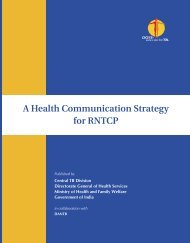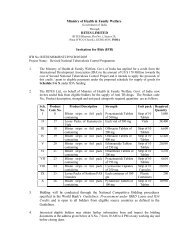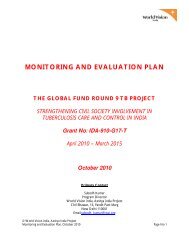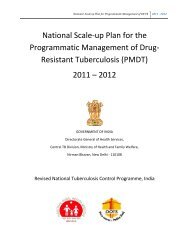RNTCP Annual Report 2012 - TBC India
RNTCP Annual Report 2012 - TBC India
RNTCP Annual Report 2012 - TBC India
Create successful ePaper yourself
Turn your PDF publications into a flip-book with our unique Google optimized e-Paper software.
Monitoring and Evaluation System:<br />
Successful implementation of even a perfectly designed<br />
programme entirely depends on a well laid out supervision<br />
and monitoring mechanism. The <strong>RNTCP</strong>, at the<br />
outset itself, had ensured that supervision and monitoring<br />
is an integral part of the programme and is well defined.<br />
Over the years, it can be correctly said, that a major<br />
reason for the success of the programme has been<br />
the effective supervision and monitoring of each<br />
programme activity and aspect.<br />
The <strong>RNTCP</strong> has a comprehensive system for regular<br />
supervision and monitoring at all levels - national, state,<br />
district and sub district. A robust surveillance structure<br />
through a well-defined recording and reporting system<br />
forms the lifeline of the <strong>RNTCP</strong> supervision and monitoring<br />
mechanism. The protocols for supervision through<br />
supervisory visits, review meetings and other means are<br />
clearly laid out in the 'Supervision and Monitoring Strategy'.<br />
Various tools to aid supervision and monitoring<br />
have also been developed and have been widely circulated<br />
for use which include checklists for supervisory visits,<br />
checklists for review meetings, and other means are clearly<br />
laid out in the 'Supervision and Monitoring Strategy'.<br />
Various tools to aid supervision and monitoring have<br />
also been developed and have been widely circulated for<br />
use which include checklists for supervisory visits, checklists<br />
for review meetings, job aids etc…<br />
The various activities and implementation aspects extensively<br />
monitored under <strong>RNTCP</strong> are Political & Administrative<br />
commitment; Human Resources including<br />
trainings; Physical Infrastructure; Drugs & Logistics;<br />
Quality of services; TB-HIV collaborative activities; Involvement<br />
of NGOs & Private Practitioners; Advocacy,<br />
Communication and Social Mobilization activities; <strong>Annual</strong><br />
Action Plans for the Districts and the States including<br />
the Financial management; Involvement of various<br />
institutions; Involvement of Community; Multi-Drug<br />
Resistant TB etc…<br />
35<br />
The main indicators to monitor <strong>RNTCP</strong> implementation<br />
broadly revolve around the number of cases diagnosed<br />
and notified, and the percentage of patients who<br />
are successfully treated among those notified. However,<br />
the programme has further clearly defined indicators for<br />
each activity under the programme, defined further for<br />
each level of service delivery focusing on just not the<br />
outputs but also the inputs and the processes. Regular<br />
feedbacks, supervisory visits, series of review meetings<br />
and internal evaluations ensure early corrections in the<br />
implementation of the programme.<br />
The process of monitoring broadly covers supervisory<br />
visits, review meetings at various levels and programme<br />
evaluation by different levels of health personnel. Measurable<br />
indicators for quality control, programme outcomes<br />
and operational effectiveness are the basis for<br />
programme monitoring.<br />
Collection, Analysis and Feedback on Routine Surveillance<br />
Data: Surveillance data are received through<br />
the monthly (till sub-district levels) and quarterly reports<br />
(from sub-district levels and upwards). The reporting till<br />
district level is paper based and from district onwards<br />
the reports are electronically transmitted to the state as<br />
well as central levels. An accurately compiled quarterly<br />
report provides base level information about the performance<br />
of the programme. Central TB Division and<br />
the States analyze these quarterly reports received from<br />
the States/Districts and feedback is provided to the districts<br />
for further analyses and corrective actions. All the<br />
states were provided feedback on the quarterly reports<br />
in 2011 while more than 60% of the states have provided<br />
feedback to the districts for all the quarters in 2011.<br />
<strong>RNTCP</strong> presently uses 'EPICENTRE' for its data management<br />
which includes collection, validation, transmission,<br />
analysis and feedback of programme performance<br />
electronically. This is presently being used successfully for






